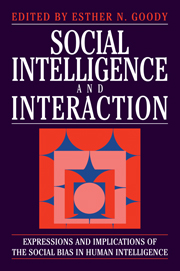 Social Intelligence and Interaction
Social Intelligence and Interaction Book contents
- Frontmatter
- Contents
- List of contributors
- Conventions used in transcripts
- Preface
- Introduction: some implications of a social origin of intelligence
- Part I Primary processes
- Part II The interactive negotiation of meaning in conversation
- Part III Genres as tools that shape interation
- 7 Politeness strategies and the attribution of intentions: the case of Tzeltal irony
- 8 Interaction planning and intersubjective adjustment of perspectives by communicative genres
- Part IV Expressions of a social bias in intelligence
- Consolidated bibliography
- Index
8 - Interaction planning and intersubjective adjustment of perspectives by communicative genres
Published online by Cambridge University Press: 09 January 2010
- Frontmatter
- Contents
- List of contributors
- Conventions used in transcripts
- Preface
- Introduction: some implications of a social origin of intelligence
- Part I Primary processes
- Part II The interactive negotiation of meaning in conversation
- Part III Genres as tools that shape interation
- 7 Politeness strategies and the attribution of intentions: the case of Tzeltal irony
- 8 Interaction planning and intersubjective adjustment of perspectives by communicative genres
- Part IV Expressions of a social bias in intelligence
- Consolidated bibliography
- Index
Summary
The aim of this chapter is to show that communicative genres play a distinct and rather important role in the reciprocal, intersubjective setting of perspectives in human communicative social interaction. It will be useful first to establish the socio-cultural context within which communicative genres perform their function and to specify the levels of theory on which propositions about communicative genres in social interaction are to be placed.
It will eventually make sense to restrict the term social interaction to behaviour with which an individual organism which is phylogenetically equipped with consciousness in its ‘biogram’ associates a more or less definite meaning (a motive, a projected goal). Here I first take the term to refer to any behaviour which is directed by one individual organism at other(s) of the same or a different species, and which has consequences for such behaviour of the other individual(s) as, in turn, is directed at the ‘first’ individual.
Social interaction in the human species may be viewed in a comparative biological perspective and compared to social behaviour in species as closely related to ours as other apes and primates and as distantly as ‘lower’ mammals. It may be compared with respect to structural and functional analogies, and possible evolutionary connections may be considered. If ethological comparison navigates successfully between the Scylla of biological reductionism and the Charybdis of anthropomorphism, it may show suggestive similarities in the structures and functions of social interaction. General features of human social interaction are also revealed by a philosophical approach.
- Type
- Chapter
- Information
- Social Intelligence and InteractionExpressions and implications of the social bias in human intelligence, pp. 175 - 186Publisher: Cambridge University PressPrint publication year: 1995
- 23
- Cited by


